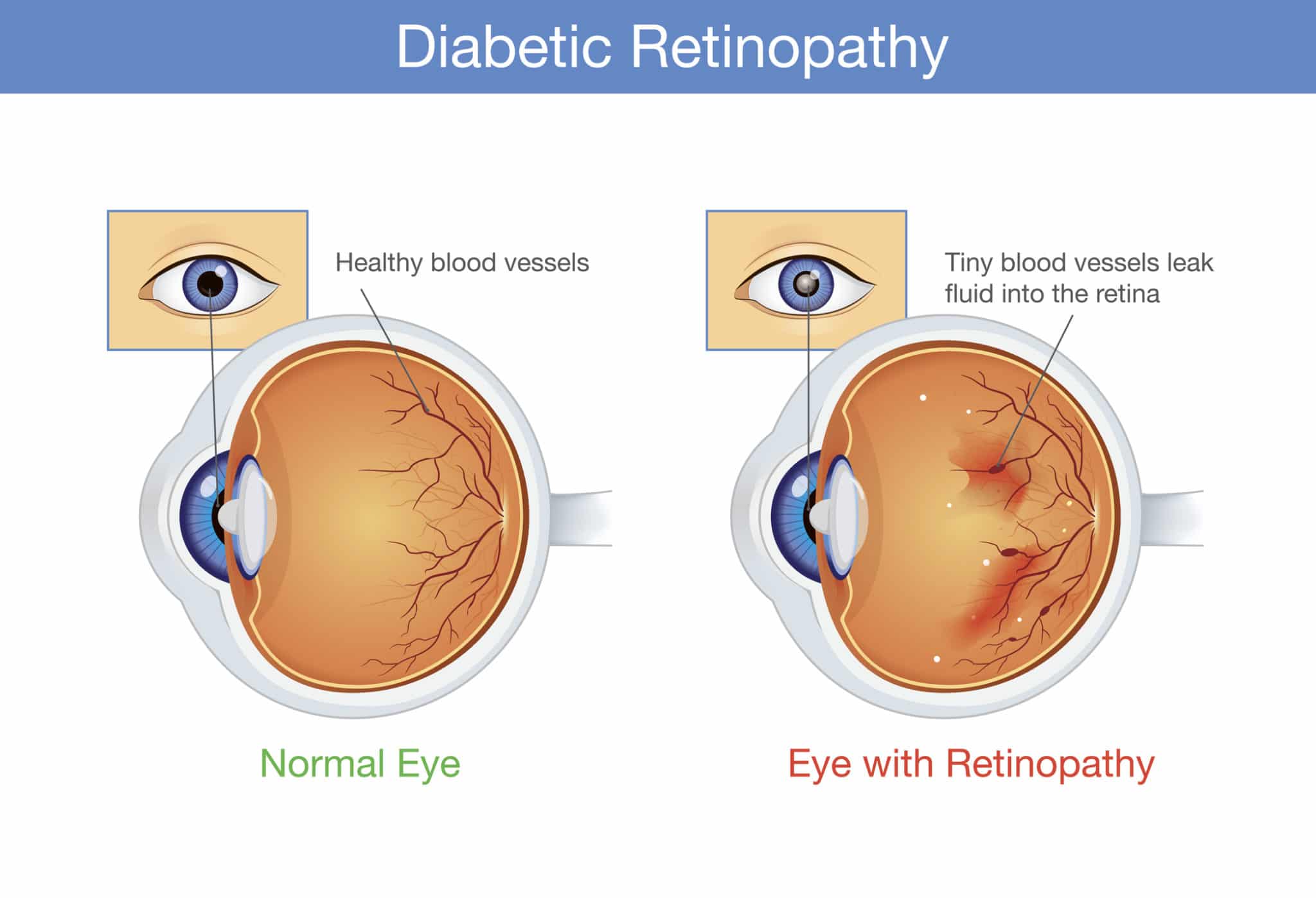Diabetic Eye Disease in North Attleboro & North Dartmouth, MA
 WHAT IS DIABETIC EYE DISEASE?
WHAT IS DIABETIC EYE DISEASE?
Patients with diabetes are at a higher risk for developing eye conditions as a complication to their disease. They are more likely to lose their precious vision. Over 40 percent of patients diagnosed with diabetes develop some form of eye disease as a result of their disease. Diabetic retinopathy is the most common diabetic eye disease and the primary cause of blindness in the United States, especially in younger populations.
Diabetes can damage blood vessels in the eye, causing blood or fluid to leak from the retina, the light-sensitive tissue at the back of the eye. It can also cause new blood vessels to grow on the surface of the retina, leading to significant damage to vision and the overall quality of life.
Diabetic eye disease is a combination of various eye conditions that develop as a result of diabetes. These conditions include:
STAGES OF DIABETIC RETINOPATHY
There are four distinct stages of diabetic retinopathy. They are:
- Mild nonproliferative retinopathy – microaneurysms, blood, develop in the tiny blood vessels of the retina.
- Moderate nonproliferative retinopathy – blood vessels to the retina become blocked.
- Severe nonproliferative retinopathy – the blood supply to the retina is blocked.
- Proliferative retinopathy – New blood vessels, to replace the blocked blood vessels, grow alongside the retina.
During any stage of diabetic retinopathy a condition known as macula edema can develop. Macula edema is the buildup of fluid in the macula, the light-sensitive part of the retina that allows us to see objects with great detail. As the macula swells vision becomes blurred. About half of the people with proliferative retinopathy are diagnosed with macula edema. Macula edema is often either monitored, treated with laser, or treated with Anti-VegF injections into the eye. Dr. Magalhaes and Associates will carefully assess each individual situation.
SYMPTOMS OF DIABETIC RETINOPATHY
Early stages of diabetic retinopathy usually do not show symptoms. Treatment is not always required. Patients need to monitor their blood sugar level to prevent the disease from progressing. If the disease does progress, prompt treatment will be necessary to preserve your vision.
Patients who develop diabetic retinopathy may not notice any changes to their vision at first. In its earliest stages, this condition causes tiny areas of swelling in the small blood vessels of the retina.
Symptoms of diabetic retinopathy may include the following:
- Vision that may be blurry or doubled
- Flashing lights
- Blank spots
- Dark floaters or spots in the vision
- Pain or pressure in either or both eyes
- Problems with peripheral vision
- Severe vision loss or blindness
DIAGNOSIS OF DIABETIC RETINOPATHY
After a thorough medical examination of the eyes, some of the following diagnostic tests will be conducted to confirm diagnosis:
- Visual acuity test
- Dilated eye examination
- Tonometry test
- Retinal exam
- Fluorescein angiogram
HOW DO YOU TREAT DIABETIC RETINOPATHY?
Other than controlling blood pressure, blood cholesterol and the levels of blood sugar, treatment is not needed during the first three stages of diabetic retinopathy. The fourth stage, proliferative retinopathy is treated with a laser surgery procedure known as scatter laser treatment. During the procedure the abnormal blood vessels are ablated causing them to shrink. This procedure works best once the blood vessels begin to bleed. Severe blood vessel bleeding may need to surgically corrected with a vitrectomy procedure to remove the blood from the eye.
Treatment for macula edema usually includes a laser procedure called focal laser treatment. During this procedure, several hundred small laser burns are placed in the areas of retinal leakage around the macula to prevent leakage from occurring and reduce the amount of fluid in the retina. This helps reduce the risk of vision loss and may improve lost vision in a small number of cases. Focal laser treatment is performed in your doctor’s office and can usually be completed in just one session.
Prevention of diabetic bleeding into the retina is best accomplished with careful and consistent eye examinations and compliant use of DVS, a strong nutraceutical found to strengthen the blood vessels of the retina. Use of this vitamin has been proven to help support the eye health of diabetics.
HOW TO REDUCE THE RISKS OF DEVELOPING DIABETIC RETINOPATHY
Patients with diabetes need to have an annual comprehensive dilated eye exam. The length of time a patient has diabetes will determine the likelihood of developing diabetic retinopathy. Generally, we like to see diabetics twice yearly. Over 40 percent of patients in the United States, diagnosed with diabetes, have a form of diabetic retinopathy.
The risks of developing diabetic eye disease can be minimized by:
- Monitoring changes in vision
- Keeping A1C levels under 7%
- Monitoring and managing blood pressure levels
- Eating a healthy diet
- Participating in a regular exercise routine
- Monitoring and managing cholesterol levels


 WHAT IS DIABETIC EYE DISEASE?
WHAT IS DIABETIC EYE DISEASE?
